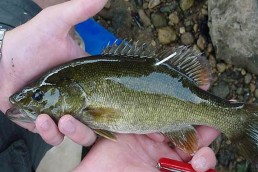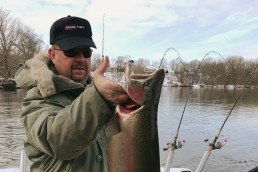St. Joe Continues to Produce Nice Bass
SHARE THIS POST
You don’t have to tell St. Joseph River anglers that the quality of bass fishing on the river is good.
Darn good.
Nor do you have to convince Indiana DNR Biologist Larry Koza, who oversees Indiana’s section of the St. Joe.
“I think the St. Joe continues to be underrated for bass, especially smallmouths,” he said. “The locals who fish it know what’s there, but I’m not sure a lot of people outside that area appreciate how good it is.”
Koza knows because he spent several hours, last fall, shocking the river looking at smallmouths for a DNR study. His crew surveyed seven stations from St. Patrick’s Park in South Bend upstream to Bristol.
It was the first time the DNR crew had taken a close look at the smallmouth population since 2013.
Although the previous survey revealed quite a few smaller fish, the numbers of legal-size fish (15 inches or bigger) that he saw last fall were pretty impressive and equivalent to what he saw in 2013.
“When you shock up three smallmouths pushing 21 inches, that’s impressive,” he said. “Equally impressive was the number of fish we saw over 15 inches.”
Big smallmouths below the dams
Koza said the stations that produced the better smallmouth fishing were similar to those they found in the 2013 study.
“The upper river station near Bristol, Ind. produced the most fish in both studies,” he said. “There’s great habitat up there and it produced several of the bigger fish.”
He also noted that stretches directly below each dam yielded quite a few smallmouths.
Are you enjoying this post?
You can be among the first to get the latest info on where to go, what to use and how to use it!
“The St. Joe smallmouths really prefer the high-current areas,” Koza said. “The worst catches of smallmouths were in the impoundment sections where the river becomes more of a lake.”
The lower section, near St. Patrick’s Park in South Bend, was pretty good too.
“Not surprisingly, the wood piles around the bank in high-current areas are where we turned up a lot of smallmouths,” he said.
One major difference between last year and the 2013 survey is the lack of one-year-old fish he encountered. When he shocked the same areas under similar conditions last fall, there weren’t as many youngsters in his collection.
Banner years for bass
“In all likelihood, 2013 was a banner spawning year for the smallmouths,” he said. “Also, we had a major flood in the river system (last year) that could have affected the smaller fish numbers, but I’m not too concerned.”
What about the bass “slot” size limit imposed on Hoosier rivers in 2012? Did he notice changes in the fishery as result of the regulation change?
Many bass tournament anglers believe the slot limit has improved the overall quality of what they are catching throughout the river.
Under the current regulation, you can’t keep any bass between 12 and 15 inches and no more than two over 15 inches. Prior to the 2012 change, anglers could keep five bass as long as they were 14 inches or longer.
Koza says it’s tough to evaluate the slot limit’s effectiveness based upon last fall’s survey.
“It’s hard to draw conclusions from one survey,” he said. “Until we do more intensive work, we really can’t evaluate that. I do think you’re seeing signs that protecting that size of fish is a good thing. Those 15-inch-plus fish are maturing to a good spawning age.”
MWO
SHARE THIS POST
Did you enjoy this post?
You can be among the first to get the latest info on where to go, what to use and how to use it!
Louie Stout
Louie Stout is a Hall of Fame journalist and longtime Bassmaster Senior Writer who has covered Indiana and Michigan outdoors for more than 40 years. He’s co-authored three books with Kevin VanDam and is the outdoors columnist for the South Bend Tribune.



